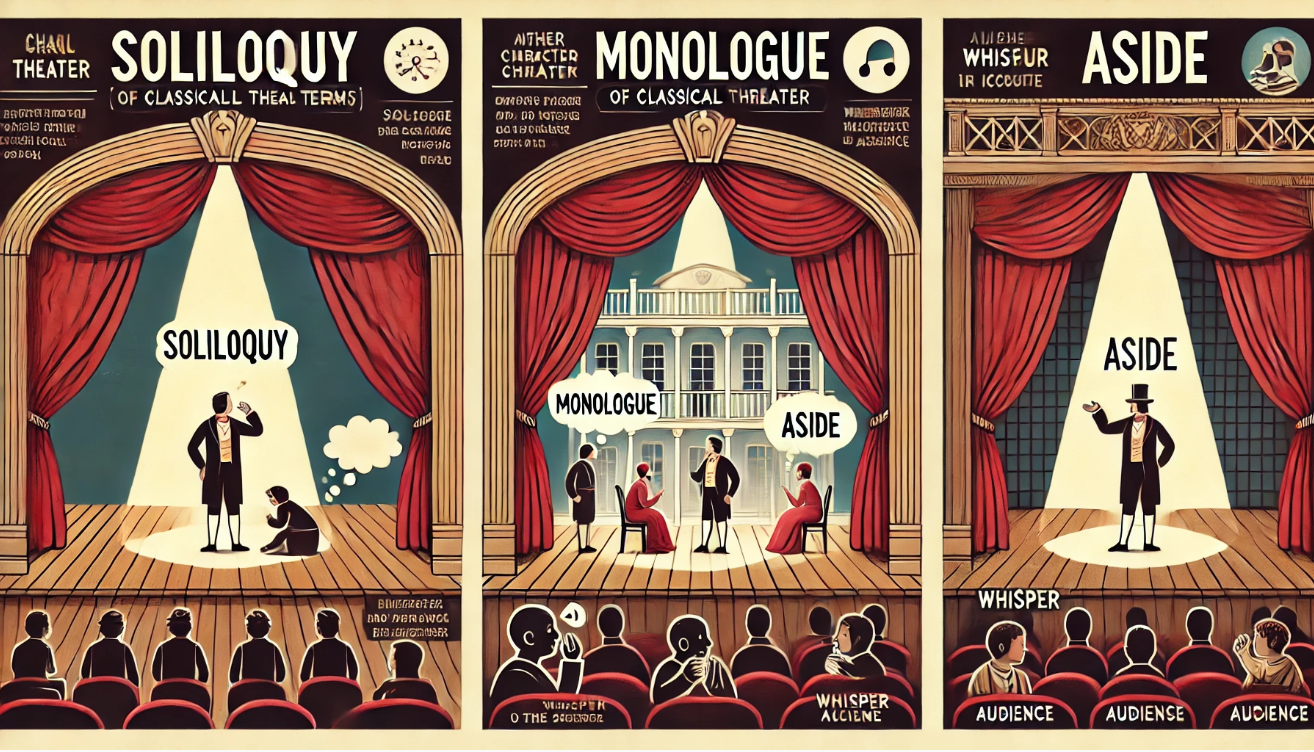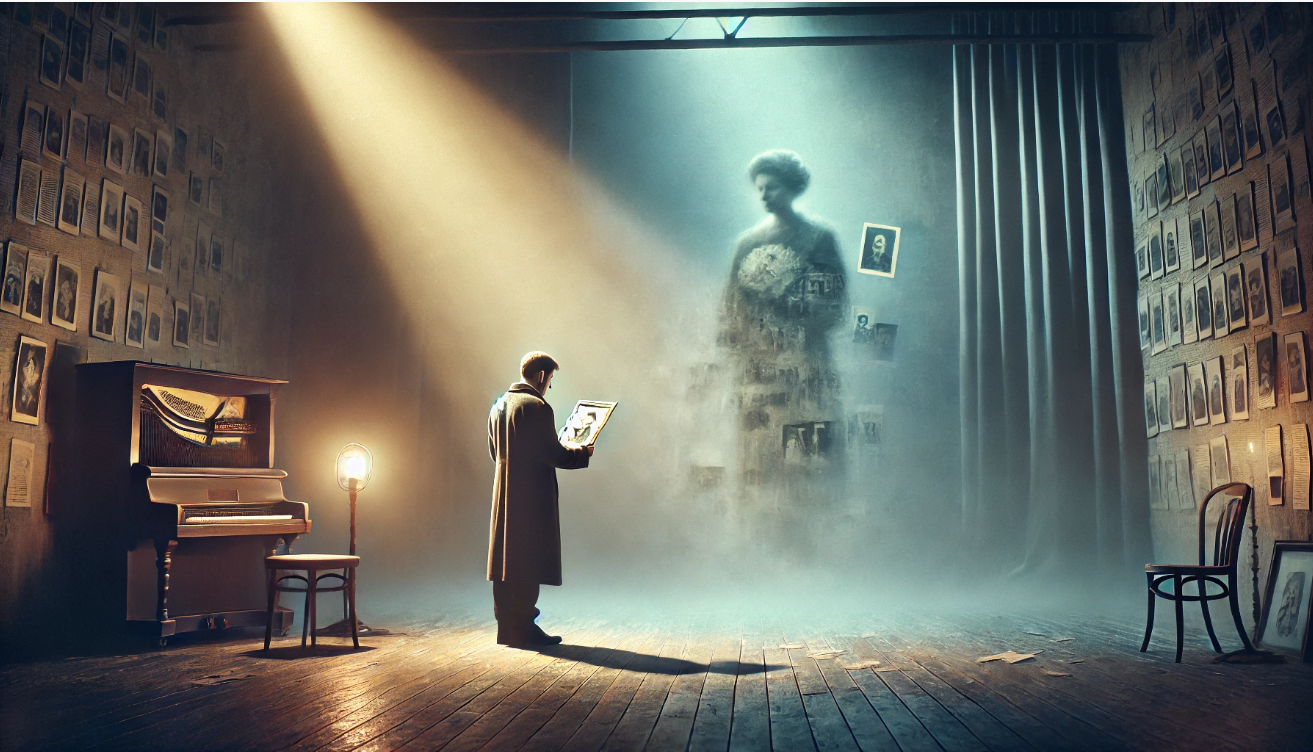
Unveiling Character Depth: The Role of Soliloquies in Character Backstories Explained
Ever wondered how a character’s deepest secrets come to life on stage? 🎭 Soliloquies—those powerful solo speeches—unlock the hidden backstories that make characters unforgettable. If you’re a student, writer, or literature lover struggling to grasp how soliloquies reveal a character’s past or why they matter, you’re not alone. This article dives into the role of soliloquies in character backstories, offering clear, beginner-friendly insights to boost your analysis or storytelling skills. Curious? Keep reading to discover practical tips that’ll transform how you connect with characters
Table of Contents
Toggle1: Understanding Soliloquies and Their Purpose 😊
Ever heard a character spill their heart out alone on stage? That’s a soliloquy! This powerful storytelling tool lets characters share their inner thoughts, giving you a front-row seat to their mind. Whether you’re a student decoding Shakespeare or a writer crafting your own story, understanding soliloquies is key to unlocking character depth. Let’s break it down simply and explore why they’re so important!

What Is a Soliloquy?
A soliloquy is when a character speaks their private thoughts out loud, usually when no one else is around. It’s like reading their diary! Unlike a monologue (a long speech to other characters) or an aside (a quick comment to the audience), soliloquies dive deep into a character’s soul. Think of Hamlet’s famous “To be or not to be” or Macbeth’s eerie dagger speech in Shakespeare’s plays.
- Key Feature: The character is alone or believes they are, making their words raw and honest.
- Examples: Hamlet wrestling with life and death or Macbeth’s guilt over his dark plans.
Why Soliloquies Are Used in Storytelling
Soliloquies aren’t just fancy speeches—they’re storytelling magic! They let writers reveal things about a character that dialogue or actions can’t. Here’s why they matter:
- Show Inner Thoughts: They uncover a character’s true feelings, like fears, dreams, or regrets.
- Reveal Backstory: Soliloquies can hint at past events that shape who the character is today.
- Build Empathy: By hearing a character’s private struggles, you feel closer to them.
- Example: In Othello, Iago’s soliloquies expose his jealousy and scheming, making his villainy chillingly clear.
Common Misconceptions About Soliloquies
New to soliloquies? Don’t worry—let’s clear up some confusion:
- Myth: Soliloquies are just characters talking to themselves randomly.
Truth: They’re carefully crafted to reveal key details about the character or plot. - Myth: Only Shakespeare used soliloquies.
Truth: Modern works like House of Cards (Frank Underwood’s asides) or Fleabag (fourth-wall breaks) use similar techniques. - Tip: Look for soliloquies in plays, movies, or even TV to spot how they deepen characters.
By understanding soliloquies, you’ll see how they bring characters to life. Ready to explore their role in backstories? Let’s dive into the next section! 🚀
2: The Role of Soliloquies in Character Backstories 😊
Soliloquies are like windows into a character’s past, revealing what makes them tick. If you’ve ever wondered why a character acts a certain way, their soliloquy often holds the answers! This section explores how soliloquies uncover backstories, add emotional depth, and drive stories forward. Whether you’re analyzing literature or crafting your own characters, these insights will help you connect the dots. Let’s dive in! 🚀
Revealing Hidden Backstories
Soliloquies shine when it comes to sharing a character’s history. They let characters talk about past events or traumas that shape their choices, giving you context for their behavior.

- How It Works: A character might reflect on a painful memory or a pivotal moment, like Hamlet mourning his father’s death in Hamlet.
- Why It Matters: Without this backstory, actions like Hamlet’s hesitation to act might seem confusing.
- Example: In Macbeth, Macbeth’s soliloquy about his “vaulting ambition” hints at his past insecurities, driving his ruthless deeds.

Tip: Look for clues in a soliloquy’s words to piece together a character’s past!
Building Emotional Depth
Soliloquies make characters feel real by showing their vulnerabilities, fears, or dreams. This emotional openness helps you relate to them, even if they’re flawed.
- How It Works: A character shares raw feelings, like Lady Macbeth’s guilt in her “Out, damned spot!” soliloquy.
- Why It Matters: It turns a villain like Lady Macbeth into a complex figure with inner conflict, not just evil.
- Example: In Romeo and Juliet, Juliet’s soliloquy about her love for Romeo reveals her fear of family conflict, making her passion relatable.
Tip: Note the emotions in a soliloquy to understand what drives the character.
Advancing the Plot
Soliloquies don’t just look back—they push the story forward by hinting at what’s next. A character’s backstory often ties to their future plans, keeping you hooked.
- How It Works: A soliloquy might reveal a character’s intentions, like Iago’s schemes in Othello rooted in his past grudges.
- Why It Matters: It builds suspense and shows how the past fuels the plot.
- Example: Iago’s soliloquies outline his plan to destroy Othello, making his betrayal clear and gripping.
Tip: Watch for hints in soliloquies about what a character might do next.
Bridging Past and Present
Soliloquies connect a character’s history to their current actions, creating a clear narrative arc. This makes their journey feel cohesive and meaningful.
- How It Works: A character reflects on how past events shape their present, like Willy Loman in Death of a Salesman recalling his failed dreams.
- Why It Matters: It helps you see why a character makes certain choices, adding depth to the story.
- Example: Willy’s introspective moments tie his past ambitions to his current despair, explaining his tragic path.
Tip: Trace a character’s soliloquies to see how their backstory evolves over time.
By revealing backstories, emotions, and plot clues, soliloquies make characters unforgettable. Ready to learn how to analyze them? Let’s move to the next section! 🌟
3: Analyzing Soliloquies for Deeper Insights 😊
Struggling to unpack a soliloquy for a class assignment or your own writing? Don’t worry! Analyzing soliloquies is easier than it seems and can reveal a character’s deepest secrets. This section offers a beginner-friendly guide to break down soliloquies, with practical steps and tips to make the process fun and insightful. Let’s unlock the hidden gems in these speeches together! 🚀
Step-by-Step Guide to Analyzing Soliloquies

Follow these simple steps to dig into any soliloquy like a pro. They’re perfect for students, readers, or writers wanting to understand characters better.
- Step 1: Identify the Context
When and why is the character speaking alone? Are they stressed, plotting, or reflecting? Context sets the stage.
Example: In Hamlet, Hamlet’s “To be or not to be” soliloquy happens as he grapples with life, death, and revenge. - Step 2: Examine the Language
Look for metaphors, tone, or vivid imagery that hint at the character’s past or feelings. Are they angry, sad, or hopeful?
Tip: Underline words like “grief” or “ambition” to spot emotional clues. - Step 3: Connect to Backstory
What does the soliloquy reveal about the character’s past? Look for mentions of events or relationships that shape them.
Example: Hamlet’s self-doubt ties to his father’s murder and his mother’s remarriage. - Step 4: Evaluate Impact
How does the soliloquy change how you see the character or the story? Does it make them more relatable or surprising?
Tip: Ask, “What did I learn about this character’s motives or struggles?”
Practical Example: Hamlet’s Soliloquy
Let’s apply these steps to a famous soliloquy: Hamlet’s “O, what a rogue and peasant slave am I!” (Hamlet, Act 2, Scene 2).
- Context: Hamlet is frustrated, watching an actor perform passionately while he delays avenging his father’s death.
- Language: Words like “rogue” and “slave” show self-loathing; metaphors like “drown the stage with tears” reveal his intense emotions.
- Backstory: He references his father’s murder and his own inaction, tied to grief and duty.
- Impact: Hamlet’s struggle becomes relatable, showing him as a conflicted hero, not just a prince.
Tip: Try these steps on any soliloquy to uncover its layers!
Tips for Students and Readers
Analyzing soliloquies can feel tricky, but these tips make it approachable:
- Annotate Key Lines: Highlight phrases that reveal emotions or past events to stay focused.
- Track Character Growth: Compare soliloquies across a play to see how the character changes.
Example: Hamlet’s early despair shifts to determination in later soliloquies. - Listen to Tone: Read the soliloquy aloud or watch a performance to catch the character’s mood.
- Use a Checklist: Context, language, backstory, impact—check each to cover all bases.
4: How Writers Can Use Soliloquies Effectively 😊
Want to make your characters leap off the page? Soliloquies are your secret weapon! These solo speeches let characters share their inner world, captivating readers or audiences. Whether you’re writing a play, novel, or screenplay, this section offers practical tips to craft soliloquies that shine. Let’s solve the problem of creating authentic, engaging soliloquies with easy, actionable steps for beginners and seasoned writers alike! ✍️
Crafting Authentic Soliloquies
A great soliloquy feels like it belongs to your character. Here’s how to write one that rings true:

- Match the Character’s Voice: Use words and tone that reflect their personality, age, and background. A teenage rebel sounds different from a scheming king!
- Reveal Something New: Share a surprising detail about their past or motives to keep readers hooked.
Example: A hero might confess a secret fear that explains their hesitation. - Keep It Natural: Write as if the character is thinking aloud, not giving a lecture.
- Tip: Read your soliloquy aloud to check if it sounds like your character.
Avoiding Common Pitfalls
Soliloquies can flop if you’re not careful. Dodge these mistakes to keep your writing sharp:
- Don’t Overuse Them: Too many soliloquies can slow the story. Use them for key moments only.
- Avoid Info Dumps: Don’t cram the entire backstory into one speech. Drop hints instead.
Example: Instead of “I was betrayed by my brother 10 years ago,” try “Why does my brother’s smile still haunt me?” - Stay Concise: Keep it short and punchy to hold attention, especially in modern formats.
- Tip: Aim for 50-100 words in a first draft, then trim unnecessary bits.
Modern Applications
Soliloquies aren’t just for dusty plays—they thrive in today’s stories! Here’s how to adapt them:
- In Film/TV: Use voiceovers or fourth-wall breaks, like Fleabag’s witty confessions or Deadpool’s cheeky asides.
- In Novels: Write internal monologues to share a character’s thoughts directly with readers.
Example: A detective might reflect on a past case while staring at a clue. - For Short Formats: Craft brief, powerful soliloquies for podcasts or web series to suit modern audiences.
- Tip: Pair soliloquies with visuals (e.g., a flashback) for extra impact in visual media.
Exercise for Writers
Ready to try? Here’s a quick exercise to flex your soliloquy skills:
- Task: Write a 100-word soliloquy for a character with a clear backstory (e.g., someone who regrets a past mistake).
- Focus: Show their emotions and a hint of their past without stating it all outright.
- Example Prompt: A chef who abandoned their family for fame.
Sample Line: “These empty plates mock me—why did I trade love for a fleeting spotlight?” - Next Step: Share it with a friend or writing group for feedback on tone and authenticity.
5: Soliloquies in Modern Media and Their Evolution 😊
Think soliloquies are stuck in Shakespeare’s time? Think again! These powerful speeches have evolved to fit today’s stories, popping up in TV, movies, and more. If you’re curious about how modern media uses soliloquies to reveal character backstories, this section breaks it down with clear examples and insights. Let’s explore how soliloquies stay relevant and keep audiences hooked! 🎬
Soliloquies Beyond Shakespeare
Modern storytellers have reinvented soliloquies to share characters’ inner worlds. They’re not just for dusty stages—they’re alive in your favorite shows and films!
- TV Examples: In Fleabag, the protagonist’s fourth-wall breaks spill her messy backstory and guilt, making her relatable.

- Film Examples: Fight Club uses the narrator’s voiceovers to reveal his psychological turmoil and past frustrations.
- Why It Works: These moments let characters “talk” to the audience, sharing secrets that deepen their story.
- Tip: Watch Fleabag or House of Cards to spot soliloquy-style confessions!
Adapting Soliloquies for Today’s Audience
Soliloquies have changed to suit modern tastes and shorter attention spans. Here’s how they’ve evolved:
- Shorter Formats: Modern soliloquies are brief and punchy, like quick voiceovers or asides, to keep viewers engaged.
- Visual Pairings: Directors combine soliloquies with flashbacks or imagery, like in The Wolf of Wall Street, where Jordan Belfort’s narration reflects on his rise and fall.
- Interactive Feel: Fourth-wall breaks, like in Deadpool, make audiences feel like part of the character’s thoughts.
- Tip: Notice how fast-paced shows use short soliloquies to drop backstory without slowing the plot.
Why Soliloquies Remain Relevant
In an age of complex, flawed characters, soliloquies are more vital than ever. Here’s why they still captivate:
- Direct Connection: They let audiences peek into a character’s mind, building empathy for even unlikeable figures, like Walter White in Breaking Bad.
- Authentic Storytelling: Today’s viewers crave raw, honest moments, and soliloquies deliver that vulnerability.
- Versatility: From podcasts to video games, soliloquies adapt to new formats, like a character’s inner monologue in The Last of Us.
- Tip: Look for soliloquy-like moments in your favorite media to see how they shape characters.
By evolving with the times, soliloquies keep stories fresh and characters unforgettable. Want to overcome common challenges with soliloquies? Let’s move to the next section! 🌟
6: Common Challenges and How to Overcome Them 😊
Feeling stuck analyzing or writing soliloquies? You’re not alone! Whether you’re a student tackling Shakespeare or a writer crafting a character’s inner thoughts, soliloquies can be tricky. This section tackles common hurdles with practical, beginner-friendly solutions to boost your confidence. Let’s solve these challenges and make soliloquies approachable and fun! 🚀
Challenge: Difficulty Understanding Soliloquies

Old language or dense emotions can make soliloquies feel like a puzzle. Here’s how to crack them:
- Solution: Break down complex words using modern translations, like No Fear Shakespeare, for clearer meaning.
- Action: Watch a performance on YouTube to catch the character’s tone and emotions. Hearing it brings the words to life!
- Example: Hamlet’s “To be or not to be” becomes easier when you see the actor’s anguish.
- Tip: Summarize the soliloquy in your own words to grasp its core ideas.
Challenge: Feeling Overwhelmed by Analysis
Analyzing a soliloquy for school or personal study can feel like too much. Simplify it with these steps:
- Solution: Focus on one aspect at a time—start with the context, then the emotions, then the backstory.
- Action: Use a checklist: What’s the setting? What’s the character feeling? How does it tie to their past?
- Example: For Macbeth’s dagger soliloquy, first note his guilt, then connect it to his ambition.
- Tip: Jot down one sentence per step to keep your analysis clear and manageable.
Challenge: Writing Soliloquies That Feel Authentic
Crafting a soliloquy that sounds real and not forced is tough. Here’s how to nail it:
- Solution: Build the soliloquy around a clear backstory and emotional goal, like regret or hope.
- Action: Write as if the character is talking to themselves, using their unique voice. Test it by reading aloud.
- Example: A grieving character might say, “Why does her laughter still echo in this empty house?”
- Tip: Get feedback from a friend to ensure the soliloquy feels natural and engaging.
Mastering Soliloquies for Deeper Storytelling 😊
Soliloquies are storytelling superstars, revealing character backstories, emotions, and motives with unmatched depth. Whether you’re decoding Hamlet’s inner turmoil or crafting a character’s heartfelt speech, mastering soliloquies unlocks richer narratives. Now that you’ve learned how to analyze and write them, it’s time to dive in! Try dissecting a soliloquy from your favorite play or penning one for a character of your own. Share your thoughts or creations in the comments or on social media—we’d love to hear your insights! Ready to transform your storytelling? Start today! 🌟
Frequently Asked Questions (FAQs)
1. How do soliloquies reveal a character's backstory?
Soliloquies give characters a chance to speak their thoughts aloud, often revealing past experiences, hidden emotions, or motivations. These insights help the audience understand what shaped the character before the story began.
2. Why are soliloquies important for character development?
Soliloquies show what a character truly thinks or feels, without outside influence. This honest self-expression helps audiences connect deeply with the character and understand their growth throughout the story.
3. Can a soliloquy explain a character’s past trauma or key life events?
Yes, soliloquies are often used to hint at or directly explain past traumas, regrets, or important turning points. These moments provide emotional context that makes the character’s present actions more meaningful.
4. What’s the difference between a soliloquy and a flashback?
A soliloquy is spoken thought, often revealing feelings or past events through words alone, while a flashback visually shows the past. Soliloquies are more personal and emotional, giving direct access to a character’s inner world.
5. How can I identify if a soliloquy is revealing backstory or just feelings?
Look for specific references to past events, names, or decisions that shaped the character. If the monologue mentions “what happened before” or “why I did this,” it’s likely tied to backstory.
6. Do modern films and TV shows still use soliloquies for backstory?
Yes, modern media often uses soliloquy-like moments, such as characters speaking to the camera or narrating their thoughts. These updated forms still serve the same purpose—giving viewers deeper insight into the character’s past and mindset.
7. Why is understanding a character’s backstory through soliloquy useful for writers and actors?
It helps writers create layered, believable characters and allows actors to portray them with emotional depth. Knowing the character’s past explains their motivations, fears, and goals, making the performance more authentic.
8. What are some famous examples of soliloquies revealing backstory?
Hamlet’s “O, that this too too solid flesh would melt” reveals grief and past family betrayal. In TV, Breaking Bad’s Walter White often reflects on his life choices, offering key backstory through inner monologues or private speeches.
